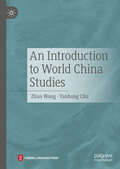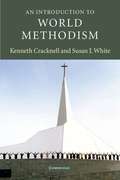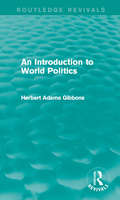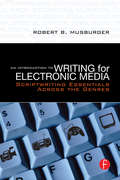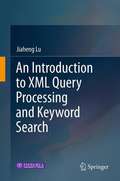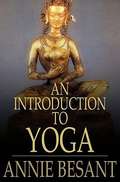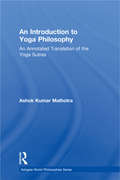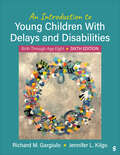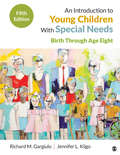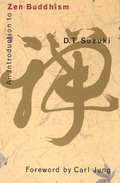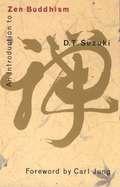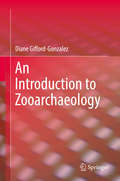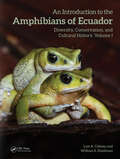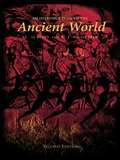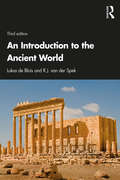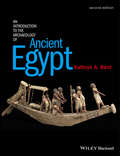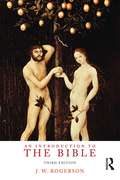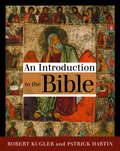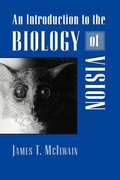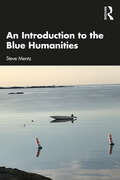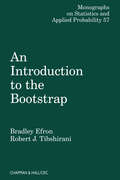- Table View
- List View
An Introduction to World China Studies
by Zhan Wang Yanhong ChuThis book examines the seven key issues related to China, which have been identified by experts over the past few centuries. The topics addressed include China's impact on international discourse, the inheritance of Chinese civilization, the great divergence between Chinese and Western histories, Kondratiev Cycle Theory, the socialist system and its future prospects, the Chinese path to modernization, and the Belt and Road Initiative. The authors explore these issues within the broader context of human civilization and the evolving global landscape, offering systematic explanations for each topic and redefining the concepts of World China Studies.
An Introduction to World Methodism
by Kenneth Cracknell Susan J. WhiteWith over 75 million currently practicing Methodists worldwide, this book treats Methodism as a global religious tradition, examining its rich diversity as well as the core beliefs and attitudes that all Methodists share. It serves as an introduction to the patterns of Methodist life, demonstrating how the religion has developed from British and American roots in different cultural contexts. In addition to the lasting traditions of John and Charles Wesley, An Introduction to Methodism reflects the on-going contribution of Methodism to the ecumenical movement and inter-religious relations. Its analysis includes abundant resources encouraging further study. Kenneth Cracknell is Professor of Theology and Global Studies at Brite Divinity School, Fort Worth, Texas. He has been a theological teacher in Nigeria, a Methodist pastor in Britain, and Director of Interfaith Relations for the British Council of Churches. He has also been a consultant to the World Council of Churches on interfaith issues since 1979 and has visited churches in all parts of the world. He is the author of Toward a New Relationship: Christians and People of Other Faith (Epworth Press, 1986) and Justice, Courtesy and Love: Theologians and Missionaries Encountering Other Religions 1846-1914 (Epworth, 1995). Susan J. White is Alberta H. and Harold L. Lunger Professor of Spiritual Resources and Disciplines at Brite Divinity School, Fort Worth, Texas. She has been a member of the Church of England Liturgical Commission, and the Joint Liturgical Group of Great Britain and Ireland, and consultant for liturgical revision to the Methodist Faith and Order Committee and the Office of Worship of the Board of Discipleship of the United Methodist Church. She is the author of Groundwork of Christian Worship (Epworth, 1997) The Spirit of Worship: The Liturgical Tradition (Orbis Books, 2000) and A History of Women in Christian Worship (Pilgrim Press, 2003)
An Introduction to World Politics (Routledge Revivals)
by Herbert Adams GibbonsOriginally published in 1922, An Introduction to World Politics, was published at a particularly interesting time in international relations, just a few short years after the first world war. With this in mind, Gibbons has approached this text as a general introduction to world politics, both examining causes of recent events in his lifetime as well as exploring what he refers to as ‘the beginning’ of World Politics. This study delves into various aspects of world politics throughout history including the colonialism of the British and the French and several wars and treaties with analysis on how this impacted on relations between nations. This title will be of interest to students of Political History and International Relations.
An Introduction to Writing for Electronic Media: Scriptwriting Essentials Across the Genres
by Robert B. MusburgerLearn what it takes to write for commercials, news, documentaries, corporate, educational, animation, games, the internet, and dramatic film & video productions * Outlines the key skills needed for a successful media writing career The demand for quality and knowledgeable multi-platform writing is always in high demand. An Introduction to Writing for Electronic Media presents a survey of the many types of electronic media you can write for, and explains how to do it. Musburger focuses on the skills you need to write for animation versus radio or television news versus corporate training. Sample scripts help you learn by example while modeling your own scripts. Production files illustrate the integral role writers' play in the production process, and individual movie frames allow you compare these to the real scripts. Armed with the skills developed in this book, a media writer can apply for a variety of positions in newsrooms, advertising firms, motion pictures or animation studios, as well as local and national cable operations. Robert B. Musburger, Ph.D., is Professor Emeritus and former Director of the School of Communication, University of Houston, USA. He has worked for 20 years in professional broadcasting, serving as camera operator, director, producer, and writer. Musburger has received numerous awards for his video work and teaching and he continues to work in electronic media with his Seattle, WA,. consulting firm, Musburger Media Services.
An Introduction to XML Query Processing and Keyword Search
by Jiaheng Lu"An Introduction to XML Query Processing and Keyword Search" systematically and comprehensively covers the latest advances in XML data searching. It presents an extensive overview of the current query processing and keyword search techniques on XML data, including XML labeling schemes, indexing, processing on order and un-order XML tree patterns, XML query optimization, results estimation, and XML keyword searches, which are elaborated in separate chapters. Graduate students and researchers in the field of XML data searching will find this book an invaluable resource. Prof. Jiaheng Lu is an associate professor at Renmin University of China's School of Information.
An Introduction to Yoga
by Annie BesantThe whole evolution is one in its essence. The succession is the same, the sequences identical. <P> <P> Whether you are thinking of the unfolding of consciousness in the universe, or in the human race, or in the individual, you can study the laws of the whole, and in Yoga you learn to apply those same laws to your own consciousness rationally and definitely. All the laws are one, however different in their stage of manifestation. If you look at Yoga in this light, then this Yoga. . .
An Introduction to Yoga Philosophy: An Annotated Translation of the Yoga Sutras (Ashgate World Philosophies Series)
by Ashok Kumar MalhotraWith its promise of personal improvement, physical well-being and spiritual enrichment, yoga is enjoying a resurgence in popularity at the turn of the third millennium. To unravel the mystery of the discipline, its philosophies and relevance in contemporary life, the original text of the Yoga Sutras of Patanjali must be explored. This book offers the first accessible translation and commentary on Patanjali's Yoga Sutras. An introductory section examines the multidimensional aspects of yoga as philosophy, psychology, science, and religion, as well as exploring popular versions of yoga in the West. The core of the book offers a new translation of the entire text of the Yoga Sutras, in a language that is clear and comprehensible to students. Commentaries are presented to highlight the meaning of various statements (sutras) and key themes are outlined via sectional summaries. A full glossary of key words and names is also provided. Concluding chapters look at yoga in contemporary life, revealing the popularity of yoga in the 21st century through Star Wars, and exploring yoga's connection to health and science, contrasting yoga's holistic view of healing with that of the limited view of present day medical science. Sample physical, breathing and meditation exercises are provided. An Introduction to Yoga Philosophy offers a comprehensive introduction to the Yoga Sutras text of Patanjali to all students and interested readers of Indian philosophy and religion, world religions, east-west psychology, and mysticism.
An Introduction to Young Children With Delays and Disabilities: Birth Through Age Eight
by Richard M. Gargiulo Jennifer L. KilgoAn Introduction to Young Children With Delays and Disabilities: Birth Through Age Eight introduces readers to educational policies, services, and practices for future educators serving young children birth through age eight with delays and disabilities in early intervention/early childhood special education (EI/ECSE). Thoughtfully and comprehensively addressing the needs of young children and their families, authors Richard M. Gargiulo and Jennifer L. Kilgo offer interventions and instructional techniques that provide students with a broad understanding of important theoretical and philosophical foundations, including evidence-based decision making, cultural and linguistic responsiveness, and appropriate instruction and interventions in classroom settings and beyond. The Sixth Edition has been thoroughly updated to incorporate the Initial Practice-Based Professional Preparation Standards for Early Interventionists/Early Childhood Special Educators developed by the Division for Early Childhood (DEC) and Council for Exceptional Children (CEC) in 2020, as well as the DEC Recommended Practices.
An Introduction to Young Children With Delays and Disabilities: Birth Through Age Eight
by Richard M. Gargiulo Jennifer L. KilgoAn Introduction to Young Children With Delays and Disabilities: Birth Through Age Eight introduces readers to educational policies, services, and practices for future educators serving young children birth through age eight with delays and disabilities in early intervention/early childhood special education (EI/ECSE). Thoughtfully and comprehensively addressing the needs of young children and their families, authors Richard M. Gargiulo and Jennifer L. Kilgo offer interventions and instructional techniques that provide students with a broad understanding of important theoretical and philosophical foundations, including evidence-based decision making, cultural and linguistic responsiveness, and appropriate instruction and interventions in classroom settings and beyond. The Sixth Edition has been thoroughly updated to incorporate the Initial Practice-Based Professional Preparation Standards for Early Interventionists/Early Childhood Special Educators developed by the Division for Early Childhood (DEC) and Council for Exceptional Children (CEC) in 2020, as well as the DEC Recommended Practices.
An Introduction to Young Children With Special Needs: Birth Through Age Eight (Education Ser.)
by Richard M. Gargiulo Dr Jennifer L. KilgoAn Introduction to Young Children with Special Needs: Birth Through Age Eight is a comprehensive introduction to educational policies, programs, practices, and services for future practitioners serving young children with delays or disabilities in early intervention-early childhood special education (EI-ECSE). Thoughtfully addressing the needs of children at risk for learning or development delays or disabilities, revered authors Richard M. Gargiulo and Jennifer L. Kilgo offer evidence-based interventions and instructional techniques that provide students with a broad understanding of important theoretical and philosophical foundations, including evidence-based decision making, developmentally appropriate practices, cultural responsiveness, and activity-based intervention.
An Introduction to Young Children With Special Needs: Birth Through Age Eight (Education Ser.)
by Richard M. Gargiulo Dr Jennifer L. KilgoAn Introduction to Young Children with Special Needs: Birth Through Age Eight is a comprehensive introduction to educational policies, programs, practices, and services for future practitioners serving young children with delays or disabilities in early intervention-early childhood special education (EI-ECSE). Thoughtfully addressing the needs of children at risk for learning or development delays or disabilities, revered authors Richard M. Gargiulo and Jennifer L. Kilgo offer evidence-based interventions and instructional techniques that provide students with a broad understanding of important theoretical and philosophical foundations, including evidence-based decision making, developmentally appropriate practices, cultural responsiveness, and activity-based intervention.
An Introduction to Young Children with Special Needs Birth Through Age Eight
by Richard M. Gargiulo Jennifer L. KilgoAN INTRODUCTION TO YOUNG CHILDREN WITH SPECIAL NEEDS offers a thorough introduction to the educational policies, programs, practices, and services specific to infants, toddlers, and preschoolers who demonstrate delays and disabilities. It also offers information about youngsters who exhibit signs of being at-risk for future programs in learning and development. Through a host of proven learning techniques, a website, and additional related resources, readers are guided to a full understanding of important theoretical and philosophical foundations in serving children whose learning is delayed. These include authentic assessments, cultural sensitivity and competence, activity-based interventions, and developmentally and individually appropriate practices. The book emphasizes instructional strategies necessary for creating inclusive learning environments, and offers recommendations throughout for using technology in the learning environment.
An Introduction to Zen Buddhism
by D. T. Suzuki Carl JungOne of the world’s leading authorities on Zen Buddhism, D. T. Suzuki was the author of more than a hundred works on the subject in both Japanese and English, and was most instrumental in bringing the teachings of Zen Buddhism to the attention of the Western world. Written in a lively, accessible, and straightforward manner, An Introduction to Zen Buddhism is illuminating for the serious student and layperson alike. Suzuki provides a complete vision of Zen, which emphasizes self-understanding and enlightenment through many systems of philosophy, psychology, and ethics. With a foreword by the renowned psychiatrist Dr. Carl Jung, this volume has been generally acknowledged a classic introduction to the subject for many years. It provides, along with Suzuki’s Essays and Manual of Zen Buddhism, a framework for living a balanced and fulfilled existence through Zen.
An Introduction to Zen Buddhism
by D. T. SuzukiThis book provides a complete vision of Zen, which emphasizes self-understanding and enlightenment through many systems of philosophy, psychology, and ethics.
An Introduction to Zoo Biology and Management
by Paul A. ReesThis book is intended as an introductory text for students studying a wide range of courses concerned with animal management, zoo biology and wildlife conservation, and should also be useful to zookeepers and other zoo professionals. It is divided into three parts. Part 1 considers the function of zoos, their history, how zoos are managed, ethics, zoo legislation and wildlife conservation law. Part 2 discusses the design of zoos and zoo exhibits, animal nutrition, reproduction, animal behaviour (including enrichment and training), animal welfare, veterinary care, animal handling and transportation. Finally, Part 3 discusses captive breeding programmes, genetics, population biology, record keeping, and the educational role of zoos, including a consideration of visitor behaviour. It concludes with a discussion of the role of zoos in the conservation of species in the wild and in species reintroductions. This book takes an international perspective and includes a wide range of examples of the operation of zoos and breeding programmes particularly in the UK, Europe, North America and Australasia. Visit www.wiley.com/go/rees/zoo to access the artwork from the book.
An Introduction to Zooarchaeology
by Diane Gifford-GonzalezThis volume is a comprehensive, critical introduction to vertebrate zooarchaeology, the field that explores the history of human relations with animals from the Pliocene to the Industrial Revolution. The book is organized into five sections, each with an introduction, that leads the reader systematically through this swiftly expanding field. Section One presents a general introduction to zooarchaeology, key definitions, and an historical survey of the emergence of zooarchaeology in the Americas, Europe, Asia, and Africa, and introduces the conceptual approach taken in the book. This volume is designed to allow readers to integrate data from the book along with that acquired elsewhere within a coherent analytical framework. Most of its chapters take the form of critical “review articles,” providing a portal into both the classic and current literature and contextualizing these with original commentary. Summaries of findings are enhanced by profuse illustrations by the author and others.
An Introduction to the Amphibians of Ecuador: Diversity, Conservation, and Cultural History
by William E. Duellman Luis A. ColomaAn Introduction to the Amphibians of Ecuador is the first of four volumes, which are comprehensive, well-illustrated, and authoritative works, making them invaluable to biologists, conservationists, and others. This initial volume delves into the cultural history of amphibians, encompassing ethnobatrachology and folklore, while summarizing the amphibian iconography found in Ecuadorian archaeology. Moreover, it covers topics such as bioprospecting, sustainable management, and biotrade activities. The history and present state of amphibian biology research are also addressed. Furthermore, it explores in comprehensive detail the rich amphibian diversity of Ecuador, providing a thorough review of biogeography, amphibian declines, and conservation.Subsequent volumes list the characteristics of each species, define each taxon, and compare them to similar other species. Natural history and reproductive behavior, where known, are described, as are data on vocalizations, larvae, and ontogenetic changes. Amphibian distributions are illustrated with physiographic maps with dots. Each volume addresses the declines, extinctions, and conservation status of each species and provides notations of their occurrence in reserves.KEY FEATURES Summarizes the ethnozoological aspects of amphibians Provides a thorough history of research Introduction to three volumes providing accounts for each of the 3 orders, 19 families, 78 genera, and over 650 species from Ecuador
An Introduction to the Ancient World
by Lukas De Blois R.J. van der Spek L De Blois R. J. van der SpekIntegrating the results of scholarly work from the past decade, the authors of An Introduction to the Ancient World, Lukas de Blois and R.J. van der Spek, have fully-updated and revised all sixteen chapters of this best-selling introductory textbook. Covering the history and culture of the ancient Near East, Greece and Rome within the framework of a short narrative history of events, this book offers an easily readable, integrated overview for students of history, classics, archaeology and philosophy, whether at college, at undergraduate level or among the wider reading public. This revised second edition offers a new section on early Christianity and more specific information on the religions, economies, and societies of the ancient Near East. There is extended coverage of Greek, Macedonian and Near Eastern history of the fourth to second centuries BC and the history of the Late Roman Republic. The consequences of Julius Caesar's violent death are covered in more detail, as are the history and society of Imperial Rome. This new edition is: comprehensive: covers 3,000 years of ancient history and provides the basis for a typical one-semester course lavishly illustrated: contains maps, line drawings and plates to support and supplement the text, with updated captions clearly and concisely written: two established and respected university teachers with thirty years' experience in the subject areas well-organized: traces the broad outline of political history but also concentrates on particular topics user-friendly: includes chapter menus, an extensive and expanded bibliography organized by subject area and three appendices, an improved introduction and the addition of an epilogue.
An Introduction to the Ancient World
by Lukas de Blois R.J. van der SpekAn Introduction to the Ancient World offers a thorough survey of the history of the ancient Near East, Greece and Rome. Covering the social, political, economic and cultural processes that have influenced later western and Near Eastern civilisations, this volume considers subjects such as the administrative structures, economies and religions of the ancient Near East, Athenian democracy, the development of classical Greek literature, the interaction of cultures in the Hellenistic world, the political and administrative system of the Roman Republic and empire, and the coming of Christianity, all within the broad outline of political history. This third edition is thoroughly updated and some chapters are completely rewritten to cover recent historical research. Changes include: more attention to economic structures and developments, and to the history of the later Roman Empire (third to sixth centuries AD); incorporation of the results of recent archaeological and historical research, and recently published studies of ancient literature; ‘boxes’ that support the main text, on topics including economic and political systems, religion and terminology; redrawn maps and new, higher-quality images; the inclusion of useful websites in the bibliography. An Introduction to the Ancient World provides an easily readable, user-friendly, integrated overview for students of ancient history, classics and archaeology. Lavishly illustrated, clearly and concisely written, and well organised, this fully updated and revised edition will remain a key resource for students beginning to investigate the civilisations of the ancient Mediterranean.
An Introduction to the Archaeology of Ancient Egypt
by Kathryn A. BardThis student-friendly introduction to the archaeology of ancient Egypt guides readers from the Paleolithic to the Greco-Roman periods, and has now been updated to include recent discoveries and new illustrations. • Superbly illustrated with photographs, maps, and site plans, with additional illustrations in this new edition • Organized into 11 chapters, covering: the history of Egyptology and Egyptian archaeology; prehistoric and pharaonic chronology and the ancient Egyptian language; geography, resources, and environment; and seven chapters organized chronologically and devoted to specific archaeological sites and evidence • Includes sections on salient topics such as the constructing the Great Pyramid at Giza and the process of mummification
An Introduction to the Bible
by J. W. RogersonA casual reader enters a bookshop looking for a Bible. However, not all the Bibles on display have the same contents! Some have more books than others, some are study editions, some use gender-free language. How did this come about? This Introduction works back through the processes by which the Bible was written, transmitted, copied and declared to be authoritative by various churches. The following topics are dealt with: What is the Bible?; How Biblical Writers Wrote; The Making of the Old Testament; The Making of the Apocrypha; The Making of the New Testament; The Canon of the Bible; The Study of the Bible; The Use of the Bible in Social, Moral and Political Questions. This updated edition takes account of developments in scholarship since the book was first published in 1999 by Penguin. The original edition has been translated into Spanish and Portuguese.
An Introduction to the Bible
by Patrick Hartin Robert A. KuglerMany current Bible “intro” volumes focus more on theories about the biblical text than on the text itself. They lack the simplicity that has become increasingly crucial as basic biblical literacy has declined. Robert Kugler and Patrick Hartin seek to remedy that problem by turning readers back to the text at hand. Their Introduction to the Bible surveys the content of all the biblical books, section by section, focusing on the Bible’s theological themes.
An Introduction to the Biology of Vision
by James T. McilwainThis textbook is intended for use in a course for undergraduate students in biology, neuroscience or psychology who have had an introductory course on the structure and function of the nervous system. Its primary purpose is to provide a working vocabulary and knowledge of the biology of vision and to acquaint students with the major themes in biological vision research. Part I treats the eye as an image-forming organ and provides an overview of the projections from the retina to key visual structures of the brain. Part II examines the functions of the retina and its central projections in greater detail, building on the introductory material of Part I. Part III treats certain special topics in vision that require this detailed knowledge of the structure and properties of the retina and visual projections.
An Introduction to the Blue Humanities
by Steve MentzAn Introduction to the Blue Humanities is the first textbook to explore the many ways humans engage with water, utilizing literary, cultural, historical, and theoretical connections and ecologies to introduce students to the history and theory of water-centric thinking. Comprised of multinational texts and materials, each chapter will provide readers with a range of primary and secondary sources, offering a fresh look at the major oceanic regions, saltwater and freshwater geographies, and the physical properties of water that characterize the Blue Humanities. Each chapter engages with carefully chosen primary texts, including frequently taught works such as Herman Melville’s Moby-Dick, Samuel Taylor Coleridge’s “Rime of the Ancient Mariner,” Homer’s Odyssey, and Luis Vaz de Camões’s Lusíads, to provide the perfect pedagogy for students to develop an understanding of the Blue Humanities chapter by chapter. Readers will gain insight into new trends in intellectual culture and the enduring history of humans thinking with and about water, ranging across the many coastlines of the World Ocean to Pacific clouds, Mediterranean lakes, Caribbean swamps, Arctic glaciers, Southern Ocean rainstorms, Atlantic groundwater, and Indian Ocean rivers. Providing new avenues for future thinking and investigation of the Blue Humanities, this volume will be ideal for both undergraduate and graduate courses engaging with the environmental humanities and oceanic literature.
An Introduction to the Bootstrap (ISSN #57)
by Bradley Efron R.J. TibshiraniAn Introduction to the Bootstrap arms scientists and engineers as well as statisticians with the computational techniques they need to analyze and understand complicated data sets. The bootstrap is a computer-based method of statistical inference that answers statistical questions without formulas and gives a direct appreciation of variance, bias, coverage, and other probabilistic phenomena. This book presents an overview of the bootstrap and related methods for assessing statistical accuracy, concentrating on the ideas rather than their mathematical justification. Not just for beginners, the presentation starts off slowly, but builds in both scope and depth to ideas that are quite sophisticated.
